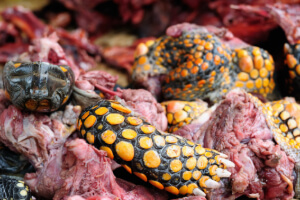
We can guess that there is a little-known type of meat that this generation of diners and cooks have forgotten about. One that is richly steeped in not just world history, but American history as well and was once the most popular type of meat to eat for families all over the country. We can also guess that you might be surprised to find out it was turtle meat.
Turtle meat and especially turtle soup was served to presidents and during presidential inaugurations, across luxury first-class trains and even in boarding houses across the country. President Taft's favorite dish was turtle soup. It was the green snapping turtle, which was readily available and abundant in the first colonies and the earliest settlers that ate turtle meat. Turtle eggs were eaten, and turtle soup or stew and various other dishes featured turtle meat instead of chicken, turkey, beef, fish, or lamb.
The flavor of turtle meat was so delectable that Americans catapulted it into near legend. The popular saying about turtle meat at the time that still holds to this day is that turtle is made up of a miscellany of meat, seven kinds—shrimp, goat, pork, fish, lamb, beef, and chicken. Of course, it is all turtle meat, yet the blend of these meat flavors remains within the flesh.
Turtle Meat History
Historically, turtles were a staple of the Caribbean diet during what is known as the Age of Exploration which began in the 15th century and lasted throughout the 17th. European sailors encountered in the West Indies enormous specimens of sea turtles that weighed hundreds of pounds found in the wild or sold live or dead in markets. Whole, butchered, dried, roasted, and more, the rich meat was an ideal diet, and the large shells perfect for cooking and heating oil rendered from turtle fat. At sea, sailors discovered turtles could live for months in saltwater without much feed necessary, becoming a much-needed emergency supply of meat in case of food shortages.
The British were the fondest of this new meat and considered it a delicacy. Common folk could not originally afford this newly transported dish, and cookbooks of the early 1700s showed highly detailed means of preparing turtle, even though at the time most who could read these books could little afford to purchase it themselves. During the 1800s the trade of turtle began to boom, finally becoming accessible to the middle class. European settlers coming to America brought with them the recipes for turtle meat meals and America at that time had great numbers of wild, smaller turtles and tortoises. They were so easily caught that American colonists began making turtle a dietary staple. These native species were plentiful, tasty, and easy to catch, paving the way to making this type of animal protein one of the favorite dishes of the country at that time.
What Happened?
How did turtle meat go from one of the most wanted, most enjoyed, and top tasting meats in America to almost completely being unheard of? Where did turtle soup and all the different turtle dishes go? Roughly 80 years ago, turtle soup and the use of turtle meat were in popular dishes in America, and then suddenly, it seemed to disappear and became something that was almost seen as unacceptable.
Why?
Turtle soup, unfortunately, became a victim of its popularity. As it migrated from the dinners of the American elite to the red and white of a soup can in the 1920s, by World War II, overwhelmed cooks had turned to tastier, cheaper, and easier canned options that became available. Harvesting turtle meat was a long and labored process to prepare it for consumption, and when time became of the essence, technology had offered more simple meal options. Americans turned to new creations such as TV dinners and canned meats.
Why Try Turtle Meat Now?
Chicken, pork, beef, and seafood account for many, and sometimes, all of the animal proteins we find on our plates. These are products we are most familiar with now, and most often, we only consume turkey once or twice a year. When was the last time you've heard of or had, snipe, mutton, rabbit, deer, or turtle?
Outside of a few pockets in Pennsylvania and Louisiana, the turtle has almost disappeared from the American diet, but many expert chefs in New Orleans and Pennsylvania praise turtle meat as one of their favorite ingredients to work with. The flavor has often been compared to being incredibly meaty, beefy with a unique texture that can be roughly compared to squid or alligator. Others have compared the succulent flavoring of turtle meat to rich crab, salmon, decadent lobster with hints occasionally of bluefish, mackerel, trout, and even sturgeon. With such a surprisingly packed flavor profile and excellent protein source, and its historical impact on American cuisine, perhaps now is the perfect time to add this flavorful meat to our rotation of meals?
Here at Wholey, we're committed to keeping both historical culinary dishes, but also fresh, excellent options for meal planning delivered right to your front door. Turtle meat is simply bursting with flavor, and our savory morsels will no doubt help you expand your culinary skills, wow guests, and impress the family. Not to mention, when you get tired of the same selection every day at other markets or your local grocery store and are looking for something to shake up your meal planning, then look no further, as we have the freshest, wild-caught, delectable snapping turtle meat you'll find anywhere today.

